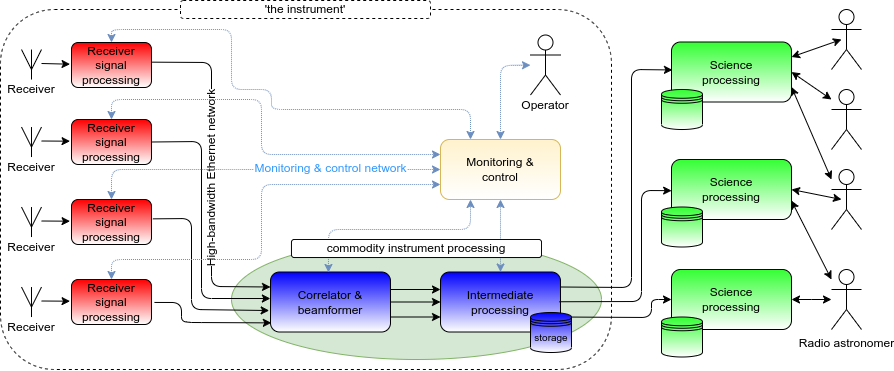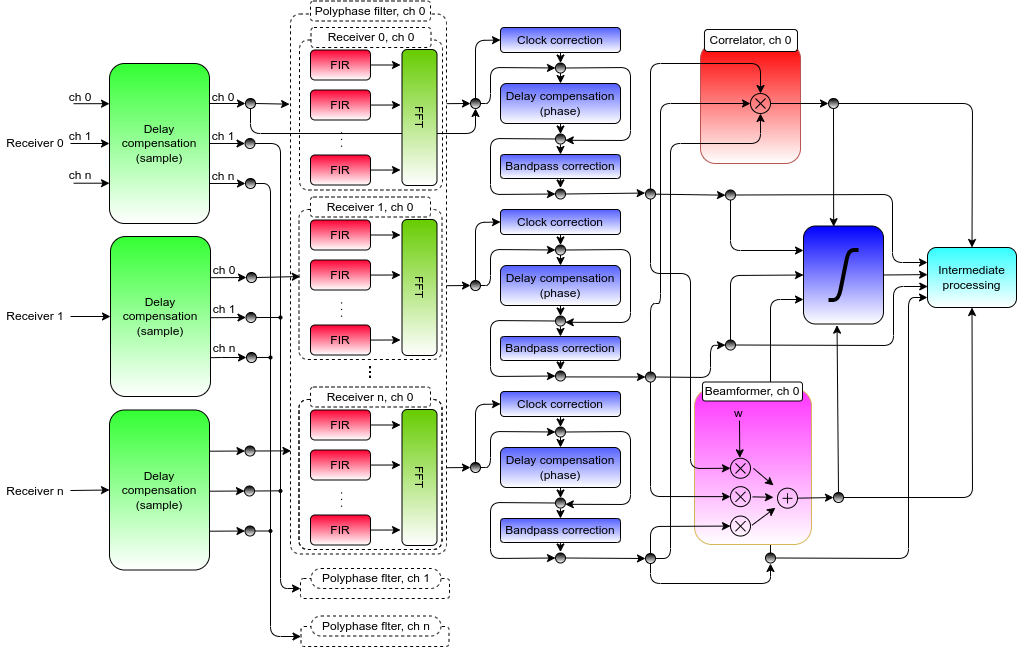Chris Broekema (broekema@astron.nl)
Introduction
A radio telescope can be considered a streaming digital signal processing system. The sky is sampled with a receiver, and almost immediately analogue data is converted to the digital domain so we can conveniently transport it without loss and use general purpose commodity hardware to do signal processing on the result. This is shown in the schematic overview below.
The vast majority of the processing is digital in nature, generally using signed complex integers. In early instruments very small words (up to single bits) were used, in state of the art telescopes words are generally in the order of 10-12 bits. For centralized digital signal processing, alternatives using general purpose computing systems are viable, in particular for low-frequency telescopes such as LOFAR. In such cases, integers are converted to floating point values due to FPUs (FLoating Point Units) being massively more available and powerful in this class of computing. Novel AI-processing units, such as tensor cores, are used in these processing steps.
Neuromorphic processing
The current massive interest in artificial neural networks has sparked a whole host of novel hardware classes optimized for such processing tasks. While most of these follow traditional digital processing paradigms, an appealing and potentially more sustainable alternative may be offered by novel neuromorphic paradigms, which directly implement Artificial Neural Networks (ANNs) in hardware. Some recent work (https://doi.org/10.1063/5.0116699) has evaluated the viability of such hardware for two High-Energy physics tasks. Based on this work, we studied in a previous assignment if receiver signal processing can be done on analogue and/or neuromorphic hardware, and what the potential energy savings could be on with such a solution.
This assignment
In this assignment we will investigate the viability and applicability of analogue neuromorphic computing for the correlator and beamforming tasks in a radio telescope. These are currently implemented in either FPGA boards or on dedicated high-performance GPU-based commodity clusters (https://doi.org/10.1016/j.ascom.2018.04.006). We will focus on the main processing functions in this component, shown below (Polyphase filterbank, beamformer, correlator), with the additional ancillary components (i.e. delay compensation, clock correction, bandpass correction, chirp removal, etc) ignored unless time remains to investigate further.
Much of the primary processing identified above can be easily written as matrix-matrix, vector-vector or matrix-vector operations. In theory, these should map well onto neuromorphic hardware.
Technologies used in this project
This project will be mostly theoretical. While the designs are being developed in the NL-ECO project among others, we cannot assume these will be available in time to be able to test real hardware in this project. However, if real hardware is available, students will be encouraged to test their approach on this if feasible.
Goals of this project
We are interested in answering the following questions:
- Can analogue neuromorphic processors be effectively used to implement a correlator and beamformer for a modern radio telescopes?
- What is the energy consumed by such a neuromorphic correlator and beamformer? How does this compare to the current state of the art?
- What, if any, losses in accuracy and/or fidelity can we expect in such a system?
What we develop
The deliverables in this project are
- a concept design of a radio telescope correlator and beamformer with an analogue neuromorphic processor
- an estimate of the energy consumption of such a system compared to the current state of the art
- an estimate of the accuracy and fidelity of such a system compared to the current state of the ar

